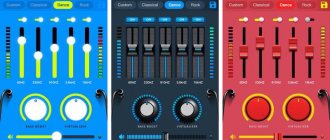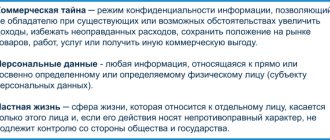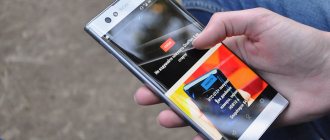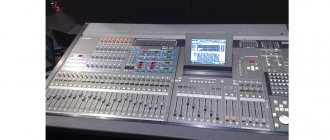Have you found the answer to the question - how do headphones affect our hearing ? We understood the rules of wearing. It's worth reading so you don't become deaf at 25.
Most often, the search query “How headphones affect hearing” leads to the same article, rewritten a hundred times. As a result, it is quite difficult to find the correct answer to the question. Now let’s understand, at least at the most basic level, what is really happening.
The material was prepared with the support of Audio-Technica.
What do they officially think about it?
Popular resources say that a person hears sounds with 10-15 dB.
A whisper is about 20dB, a normal conversation is about 30dB, and a scream is about 60dB. The limit of harmless noise level for hearing is approximately 80 dB. According to most reference tables, this is the noise level in the subway. The real danger comes from 110 dB . According to most news agencies, the noise level in headphones is approximately 105-120 dB. Well, it's like an airplane engine under your ear.
Let's figure it out further. It is officially accepted that the most serious impact on hearing comes from in-ear headphones. Only because they are much closer to the eardrums. Of course, vacuum (in-ear) headphones are even more harmful. They direct sound directly to the eardrum.
Contradictory statements add fuel to the fire: “If you regularly listen to music in this type of headphones for 3-4 years, you are at risk of hearing loss of 1 degree. You can listen to music with in-ear headphones for no more than 30-40 minutes a day, and with regular headphones - no more than 1 - 1.5 hours. In this case, the volume should not be maximum, 60% is enough.”
Clinical case. What is 60% and from what value are they measured if I have custom firmware for the player/smartphone? Why have I been wearing in-ear headphones for 15 years and have excellent hearing for my age? Plus, my headphones can output no more than 85 dB (okay, 95).
So there is no harm, the doctors are lying? Not everything is so simple. The copywriters just screwed up once again.
Opinions of free “experts”
“Since childhood, I had a keen ear, but at the age of 14 I became very interested in hard rock, my parents objected to loud music in the apartment, and I listened to my favorite bands through headphones. Of course it's loud. The hearing has gone down, the former sensitivity is gone. This is not a disease, I asked during the medical examination, but now I really regret it. So don’t repeat my mistakes if you value hearing acuity.”
“I recently noticed that fellow DJs began to put their palm to their ear in order to hear their interlocutor at a distance. And now I myself play with the monitors turned up to full volume.”
“Rock music on headphones is especially harmful to hearing. You can listen to it no more than 10-15 minutes a day. Beat and classics - up to 14 hours. The main thing is to use good headphones. For example, I use Beats by Dr. Dre - they sound great and don’t damage my hearing.”
Sound insulation: ear pads and cups
Any ear pads have only one common quality: they deteriorate over time, even if it’s not noticeable. Compare with new ones. Maybe it will turn out that after six months or a year they become softer, more comfortable, and the sound has become softer.
But more often the opposite situations happen: the material has become loose, the height has decreased, and the compositions take on a cotton-like shade.
The simplest modification to any over-ear (or any other) headphones is replacing the ear pads. There are no rules when changing - you have to search and experiment. Not only each manufacturer, but also each series (if it’s not like a huge audio holding company) can have its own properties.
Therefore, when replacing there are no rules. The main thing is that the material provides not only a comfortable fit, but also shades of sound: dense leather better reflects audio waves (adds volume), fine-pored dense filling works more effectively as a sound insulator and “increases” the volume of low frequencies.
Soft ear pads muffle sound. This is especially true when filled with fibrous materials. But they are much nicer for everyday wear.
By the way, no one bothers you to choose monitor ear pads for a compact model of headphones: either by fitting store-bought ones of a different size, or by adapting suitable ones from another manufacturer. In addition to convenience, Cheburashkas always sound “richer” - re-reflections of sound.
Human Hearing: Truth
Headphones can be harmful. Just like any other sound sources. We can definitely say that any loud sounds damage hearing if exposed to them for a long time. Even the monotonous rumble of an engine or the background noise of the subway.
It is very difficult to unambiguously determine the rate of hearing loss. In any case, it decreases with age. The child hears sounds from 10-15 Hz to 20 kHz. An adult - already from 15-20 Hz to 16 kHz. Moreover, each sound frequency has its own sensitivity, which also decreases with age.
Typically, at a frequency of 10 kHz, the ear sensitivity of a 60-year-old person is 20-25% dB lower than that of a 20-year-old. This is the result of organ development, body development, tissue aging. A lot of factors are involved in the process, ranging from tissue sensitivity to neurophysiology.
In addition, the hearing organs work nonlinearly. The science that studies hearing, psychoacoustics, is one of the most complex types of medical physics (or, if you prefer, anatomy). What we hear, how we hear, and the result of listening cannot be described by the formula “A+B = bad hearing.”
The acoustic wave in human ears is converted into sets of nerve impulses. That is, “quantization” occurs - the division of the wave into individual elements.
The coding possibilities are not limitless. The ear perceives a limited number of simultaneous sounds, distinguishes a limited number of tones and musical intervals, and cannot recognize sounds that are too fast and too slow.
Related to this is the concept of “sound masking ,” which is responsible for the fact that out of several sounds a person can clearly distinguish only one; External noise reduces the intelligibility of music and increased volume is required.
You can read in detail about all such phenomena in textbooks on sound acoustics. Today we will try to explain and discuss one of the theories about the dangers of headphones.
Real and imaginary harm of headphones
The louder the music in the headphones, the worse it is for your hearing. This is absolutely true and simple. Higher volume means higher pressure, higher energy transmitted by the acoustic wave, higher wear and tear on the hearing organs (yes, they wear out in the same way as joints and other tissues of the body). The proximity of the sound source does not affect the rate of hearing loss.
In addition, there is fatigue of certain parts of the inner ear, which initially serves as a mechanism for protecting human hearing from the effects of loud sounds. Have you noticed that after visiting a club for a day or two, the world seems a little muted? It is the ears that save themselves by temporarily reducing sensitivity to preserve subsequent functionality.
Other factors have little influence. And how many of them can you name? Type of music, speed of music, quality of music? This relates more to the parameters of sound perception and neurology. Although the need to strain in order to make out what is heard can also negatively affect hearing later.
We remembered about camouflage for a reason. The fact is that the higher the background noise, the louder the music must be in order to be heard. It follows that the least harmful headphones are those in which you can get by with a low volume level. With good noise insulation: overhead monitors and vacuum plugs.
Open headphones transmit less dense sound into the ear and allow for more uniform wave propagation. And from the point of view of the influence of the wave on matter, it is less harmful. But in noisy places they cause the volume to be turned up and can cause serious injury. Which will not become noticeable immediately.
We are finalizing sound guides and other sound guides
The speaker is rarely attached directly to the ear cup. And the plate on which it is placed is, in good models, secured through a gasket made of paper or other material. Here’s another “mod”: by making a gasket between the two parts of the earphone, you can improve the insulation or partially change the sound.
Paper does not provide complete insulation, but it does not muffle the sound or erase the upper range (yes, crevices can also play a role in the sound). If you use felt, you can achieve complete insulation. At the same time, the bass will become brighter, but slightly duller.
By the way, if you “cover up” the extra holes and cracks with epoxy or some kind of natural glue, you can get a similar (but different) result. Options can be combined.
The emitter protection is also undergoing changes. Manufacturers install plastic grilles to save money. By replacing them with a metal mesh covered with thin paper for filtration, the sound of any model can be radically changed. For the better.
Such a “feint” will not work with expensive models: most likely, the manufacturing company was concerned with the sound design, and all the holes in front of the speaker appeared as a result of calculations. There is a risk of damage if the protection is not removable.
Recommendations for hearing protection
At home, it is recommended to use open-back headphones. Even better - conventional acoustic systems of any kind. In any case, it is necessary to minimize the influence of waves on the inner ear and move away the sound source.
Don't get carried away with speaker systems with exorbitant reproduced frequencies. They are still not audible, but they can affect the tissues of the hearing organs - the process of energy transfer still occurs, and the ear still tries to work up to a certain point. Why overload it?
In the music itself, it is worth limiting the range of high frequencies, especially at high volumes. Yes, with age, the high ones will be heard worse - but constant “training” will not delay this time. Rather, it will bring it closer.
In noisy places, you should first of all think about good sound insulation. Such that you can listen to something on headphones at the same volume as when listening in silence.
For in-ear headphones, this will most likely be foam (by the way, they solve the problem of excessive sound pressure even at low volumes, since they absorb sound well).
For overhead ear pads, it is necessary to select the right ear pads. And the model of headphones themselves - they should be comfortable.
Don't try to stun yourself. How to determine the correct volume level? A comfortable volume level is one at which the greatest intelligibility of the mid-range is achieved (a person hears low frequencies best).
If you cannot achieve complete isolation from the outside world, do not turn up the volume. It’s better to give up music altogether than to once again force your ears to work to the limit.
Disable the microphone (service) on Bluetooth headphones
If the solution that I showed above did not help, then you can try disabling the “Wireless telephone service” in the properties of our Bluetooth headphones. After which the computer will see these headphones simply as headphones, and not a headset. “Headphone” will disappear in the sound settings. And in the Windows 10 settings next to the device it will simply say “Connected music” (without “voice”).
- We need to go to the classic “Control Panel”. In Windows 7 we open it in the usual way (in the Start menu), and in Windows 10 - through search.
- Find and open the “Devices and Printers” section.
- There should be our wireless headphones in the list of devices. Right-click on them and select properties.
- Go to the “Services” tab uncheck the "Wireless telephone" service and click “Apply” and “Ok”.
The control panel can be closed.
After we disabled the Bluetooth Wireless Phone service, Windows 10 will not use the microphone on the headphones. She won't see him at all. As I wrote above, the “Headphone” will be completely disabled.
After this, the problem with bad sound should definitely go away. If not, remove the headphones, restart your computer, and reconnect them.
Important! Don't forget that you have turned off your Wireless Phone service. If you need to use the microphone on wireless headphones, you will need to turn it back on, otherwise the headphones will not work in headset mode.
What to do, if…
Slow wear and tear of the inner ear cannot be treated. In the early stages of hearing disorders, drug therapy is possible, but it lasts 12-72 hours. In advanced cases, there are no solutions - only a hearing aid.
The first call about serious problems is a deterioration in the understanding of the interlocutor. As soon as a stranger’s speech becomes unintelligible, as soon as you want to ask again about an unintelligible phrase, you should run to the doctor. If the diagnosis is confirmed, the otolaryngologist will tell you how to behave in the future.
Doctors recommend periodic hearing tests. It is not expensive. But in addition to hearing problems, it allows us to identify other diseases that cause hearing complications. These include not only the well-known hypertension, but also intestinal diseases, for example.
Remember - a healthy mind in a healthy body. Take care of yourself and your hearing.
( 49 votes, overall rating: 4.78 out of 5)











